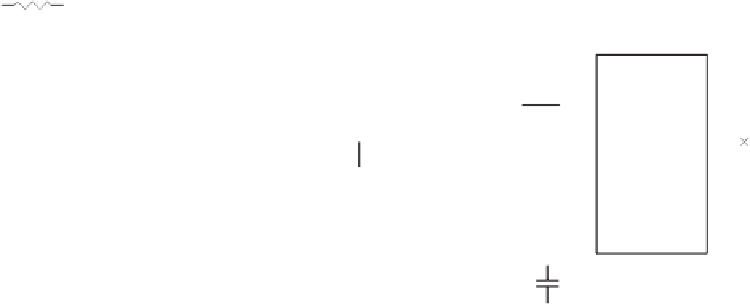Biomedical Engineering Reference
In-Depth Information
+12V_ISO
-12V_ISO
ISO_GND
D8
C25
100pF
R21
10M
D7
FDH300
FDH300
J2
ISO
1
R22
+VIN
1
IC5
INA110AG
2mm
100k
IS-1-3.3DP
FRONT_END_OUT
JP1
C26
1nF
2
9
+IN
OUT
1
-IN
10
OSENSE
13
ISO1
IS-1-3.3DP
1
2
X10
1
16
6
J3
3
4
X100
X200
REF
R23
5
6
11
14
-VIN
1
7
8
X500
OOADJ
15
OOADJ
3
2mm
100k
RG
C27
100pF
R24
10M
4
5
D9
FDH300
D10
ISO_GND
IOADJ
IOADJ
8
+12V_ISO
FDH300
+VCC
7
-VCC
-12V_ISO
ISO_GND
C29
0.01uF
C28
0.01uF
-12V_ISO
+12V_ISO
ISO_GND
Figure 2.2
This wideband dc-coupled biopotential amplifier front end covers the complete frequency range of commonly recorded biopo-
tentials. A Burr-Brown INA110AG ICIA is dc-coupled to the electrodes via current-limiting resistors R22 and R23 and IS-1-3.3DP fault-
current limiters. Capacitors and diodes are used to protect the amplifier from high-frequency currents, such as those used in electrosurgery
and ablation procedures as well as from high-voltage transients such as those that may be expected from defibrillation and electrostatic
discharge.
input of the op-amp should be shielded against stray and leakage currents through a guard
ring on the circuit board. The output of the integrator/S&H is summed with the output of
IC2B via R4. The output of IC2A is also attenuated via R6 and R8 and summed with the
output of the isolation ampli
fi
er (IC3) via R7. This trick allows of
ff
sets that would other-
wise saturate ampli
ective way.
A typical application for a dc-coupled wideband biopotential ampli
fi
er IC2B to be canceled in a very e
ff
er is the measure-
ment of transmembrane potentials as well as for the detection of cardiac monophasic
action potentials (MAPs). Dc coupling is important for these applications because they are
usually related to measuring the timing and amplitude of shifts in potentials that have a dc
o
fi
ff
set.
BIOPOTENTIAL AMPLIFIER WITH DC REJECTION
Unlike transmembrane and MAP signals, most biopotential recordings made with extra-
cellular electrodes contain signals of physiological interest only at frequencies above dc.
In fact, very low frequency components are usually the result of unwanted electrochemi-
cal processes at the electrodes, generating potentials that disturb or obscure the signal of
interest. Dc potentials caused by electrode polarization and “injury” currents limit the gain
that can be given to input stages so as to keep them away from saturation. In addition, the
e
ect of changes in electrode contact, temperature, and hydration induce slow changes in
the level of polarization, which shows in dc-coupled biopotential recordings as baseline
wander.
ff









































Search WWH ::

Custom Search